Equivalent definitions of adjoint functors
-
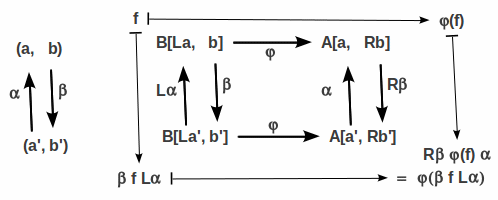 Given two categories A, B and two functors L: A --> B and R: A <-- B. L is left adjoint to R iff there is a natural isomorphism
Given two categories A, B and two functors L: A --> B and R: A <-- B. L is left adjoint to R iff there is a natural isomorphism
- φ: R[L _, _ ] --> L[ _, R _ ]
- natural isomorphism means that the φa,b build a natural transformation Aop × B --> Set and that each φa,b is a bijection
- Given two categories A, B and two functors L: A --> B and R: A <-- B. L is left adjoint to R iff there are natural transformations
- the unit ε: LR --> 1B and
- the counit η: 1A --> RL
- with the triangle equations
- Rε • ηR = 1, i.e. ∀ b ∈ B: Rεb • ηRb = 1b, namely Rb --ηRb--> RLRb --Rεb--> Rb and
- εL • Lη = 1, i.e. ∀ a ∈ A: εLa • Lηa = 1a, namely La --Lηa --> LRLa--εLa--> La
-
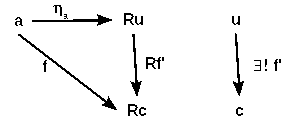 Given two categories A, B and a functor R: A <-- B and
Given two categories A, B and a functor R: A <-- B and
- ∀a ∈ A there is an universal arrow ηa: a --> Ru for R,
- i.e. ∀ f: a --> Rc ∃! f': u --> c with f = ηa • Rf'
- the dual with a functor L: A --> B and couniversal arrows
Proof: 1 ⇒ 2
-
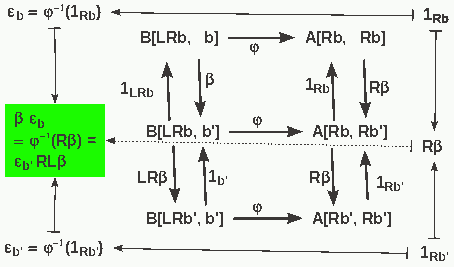 define εb = φ-1(1Rb)
define εb = φ-1(1Rb)
- the diagram shows, that this defines a morphism εb: RLb --> b and that it is natural
- (furhtermore, the equation in the green box shows that φ is defineded by its values on 1, this is the contents of the yoneda lemma)
- dually ηa = φ(1La) is a natural transformation
- This diagram prooves one of the dual triangle equations.
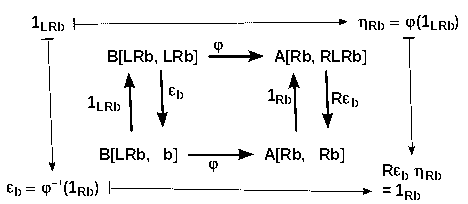
Proof: 2 ⇒ 3
-
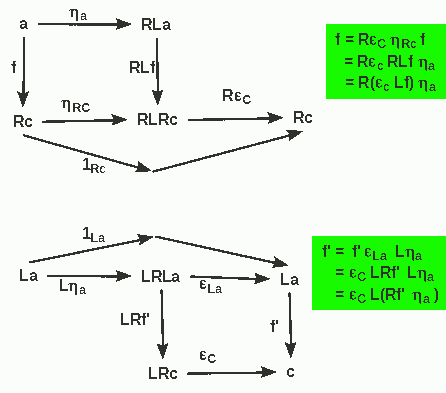 Given a ∈ A we use a --ηa--> RLa as universal arrow.
Given a ∈ A we use a --ηa--> RLa as universal arrow.
- For any f: a --> Rc we find the required f' = εc Lf : La --> c as shown in the upper diagram
- On the other hand, the lower diagram shows that each such f' can be calculated from Rf' ηa which is nothing but the original f. Thus it is unique.
Proof: 3 ⇒ 1
-
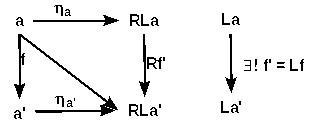 we construct L as
we construct L as
- the image La of an object a ∈ A is u from the universal arrow a --> Ru
- the image Lf of a morphism f: a --> a' is the unique (ηa' f)' of the universal arrow a --ηa--> La for ηa' f
- we define φa, b: [La, b] --> [a, Rb] as f' |--> Rf' ηa
-
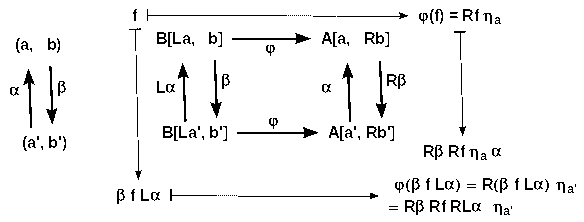 φa, b is bijective because of the ∃! in the universal arrow
φa, b is bijective because of the ∃! in the universal arrow
- the diagram beside spells out naturality of φ. But by construction of L we have ηa α = RLα ηa'. Thus, the diagram is commuatitve, and hence, φ natural.
- thus, φ is the required natural isomorphism [L_, _] --> [_, R_] for the adjunction
Proof: ⇐ 4 ⇒
- we omit these proofs because 3 and 4 are dual, left and right adjoint are dual, etc..
